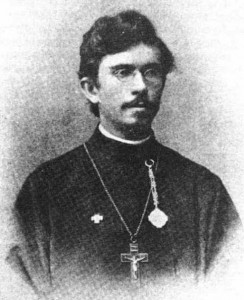On November 4, 1905, a religious and literary journal entitled The Friend published a letter by St. Alexander Hotovitzky, dean of St. Nicholas Cathedral in New York. Hotovitzky wrote in response to an article in The Friend which claimed, “In this Russian service, of course, no one understood what was said, not even the Russians themselves, as the whole of it was in the ancient ecclesiastical Slavonic tongue. As the Romish Church addresses the Lord in Latin, so do the Greeks use this Slavonic language.” Here is Hotovitzky’s reply:
This is not true.
1. Our ecclesiastical Slavonic tongue is the original of modern Russian, Servian, Slavonian, and of other branches of the Slavic world.
2. Every Russian, even children (of school age) understands well the real text and meaning of all prayers in Slavonic, excluding, perhaps, not many expressions which are lost for living use and are not fitting for ordinary practice.
3. Easy to be understood, this Slavonic language has, besides, immense dignity of words, and is sanctified as proper church language by long ecclesiastical usage.
4. To compare the use of the Latin tongue in the Roman Church and of Slavonic in the Russian is, then, far from consistency and knowledge of true conditions of things, because the chief rule of the Eastern Church (which combines Russia, Greece, Jerusalem, Antiochia, etc.) is to say the divine services in the language of the people for whom the services are intended; in Japan we celebrate and preach in Japanese, in China in Chinese, in Alaska in the native tongue of the Aleutians, and in some churches of America in English, always according to the needs and understanding of the congregation.
5. Russians do not understand Greek, and Greeks do not understand the Russian; so in a Greek church you never hear one word of the Slavonic tongue, and vice versa; yet both are of the same Eastern Catholic confession.
A. Hotovitzky, Dean of the Russian St. Nicholas Cathedral.
New York, Ninth Month 24, 1905.
I’m particularly interested in St. Alexander’s point about the use of English in some American Orthodox parishes. This was 1905; the very next year, Isabel Hapgood published her landmark English translation of the Service Book, facilitating the wider use of English. But Slavonic would remain the dominant language of the Russian Archdiocese for years to come. The 1916 Census of Religious Bodies reports that 166 of the 169 Russian Orthodox congregations in America worshipped exclusively in Slavonic.
In fact, among American Orthodox groups, only St. Raphael’s Syrians (Antiochians) really embraced English in the early years of the 20th century. Although they liturgized exclusively in Arabic in 1906, by 1916, over half of the Syrian parishes had completely switched to English, and numerous others had incorporated English to one degree or another. In fact, in 1916, no more than four of the 25 Syrian congregations continued to worship in Arabic alone. It was a remarkable, dramatic shift that probably had several contributing causes, including the vision of St. Raphael, the influence of Fr. Ingram Nathaniel Irvine, and the translation work of Isabel Hapgood. For more, check out my article from August 21 of last year.
[This article was written by Matthew Namee.]
